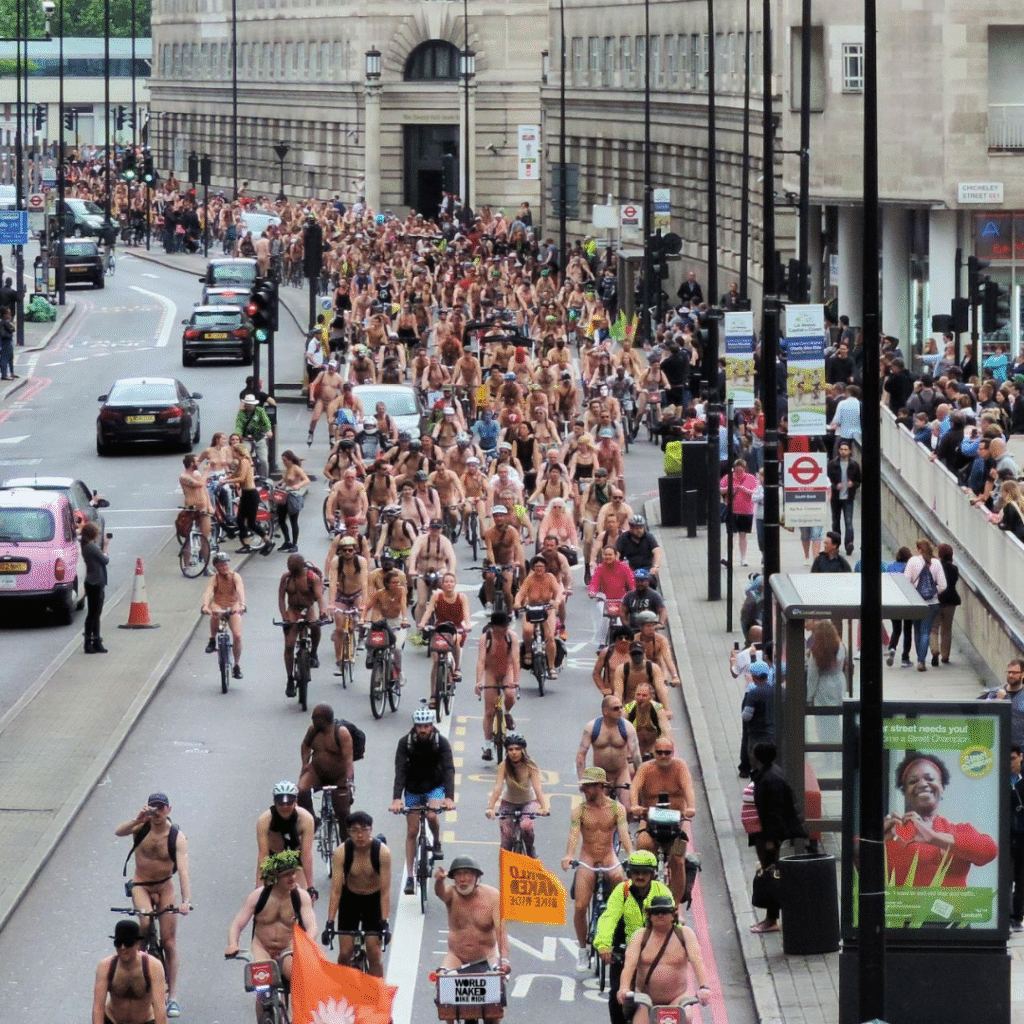

Florida Bans Rainbow Crosswalks, Accidentally Inspires Statewide Sidewalk Pride Revolution
Florida lawmakers have officially declared war on rainbow crosswalks, citing the need for “safety, uniformity, and making sure no one feels joy while crossing the street.” But in their noble quest to protect the sanctity of white paint, they overlooked a glaring loophole: the rest of Florida.
That’s right. While rainbow stripes are banished from crosswalks, nothing in the law prevents residents from painting sidewalks, driveways, parking lots, benches, planters, mailboxes, front porches, doghouses, or their neighbor’s boat trailers in dazzling technicolor. If it isn’t officially a crosswalk, it’s fair game.
So congratulations, Tallahassee — you’ve just ignited the biggest paint-buying spree in Florida history. Sherwin-Williams reports their “Unstoppable Unicorn Rainbow Collection” is now sold out from Pensacola to Key West, while Lowe’s has issued a public plea: “Please, stop asking if we carry glitter asphalt sealant.”
Neighborhoods are now erupting in a DIY Pride renaissance. Whole condo associations are repainting their parking lots into acid-trip checkerboards. Retirees in Naples are striping their golf cart paths with rainbow gradients so intense they can be seen from space. Even HOA boards, long thought to be humorless tyrants, are whispering, “Well… the law doesn’t say anything about the shuffleboard courts.”
And the murals? Oh, the murals. With rainbow crosswalks gone, Florida walls have become canvases for passive-aggressive masterpieces: 100-foot flamingos strutting under rainbow arches, rainbow gators sunbathing by pastel swamps, and one bold homeowner in Collier County who covered his garage door with a rainbow so bright it now doubles as a lighthouse.
The irony is palpable: in banning one small splash of color, officials may have triggered an entire rainbow arms race. Soon, Florida won’t be crossed on rainbow walkways — it’ll simply be rainbow.
In other words: Nice try, lawmakers. But you can’t scrub the rainbow from Florida. You’ve just guaranteed the Sunshine State’s new motto will be:
🌈 “If it isn’t a crosswalk, it’s a canvas.”
Step 1: Secure Your Arsenal of Paint
Skip the boring beige and “eggshell white.”
Buy every rainbow shade possible. Pro tip: when the hardware clerk asks, “Big project?” just say, “Yes. The future.”
Bonus points for glitter sealant — Florida humidity deserves sparkle.
Step 2: Target Sidewalks First
If they wanted sidewalks plain, they would’ve banned them too. A pastel sidewalk is fine, but imagine a rainbow hopscotch path leading to your HOA president’s mailbox. Now that’s community spirit.
Step 3: Driveways = Your Personal Runway
Forget dull gray concrete. Paint your driveway like a Pride Parade float landing strip. Each time Amazon drops off a package, they’ll feel like they’ve arrived at Studio 54.
Step 4: Parking Lots of Glory
The law says crosswalks must be white — but parking spots? Totally fair game. Want to park in “Hot Pink” today instead of “Blue Sparkle”? Live your truth, Karen.
Step 5: Benches and Planters
Benches: paint them rainbow so every passerby literally sits on equality.
Planters: make your ferns look like they were potted in Skittles. If lawmakers complain, offer them a seat — preferably the purple stripe.
Step 6: Murals Everywhere
Murals are Florida’s loophole jackpot. Slap a 40-foot rainbow manatee on the side of your condo. Spray-paint rainbow sunglasses onto every alligator mural in town. Call it “public art” and dare them to argue with culture.
Step 7: Bonus Round – Unstoppable Innovation
Shuffleboard courts? Rainbow.
Boat docks? Rainbow.
Golf cart paths in The Villages? Oh honey, especially rainbow.
Retile your pool in rainbow gradients so even the iguanas swim in technicolor rebellion.
Step 8: Declare Victory
When the state asks, “But where are the rainbow crosswalks?” you can say, “Oh, those? We don’t need them. The whole damn state is rainbow now.”
🌈 Final Motto: If they ban one rainbow, we’ll paint seven more.

World Naked Bike Ride: Humanity’s Bold Stand Against Fossil Fuels, Fabric, and Dignity
Planet Earth — This weekend, cities around the world once again witnessed that most noble of traditions: the World Naked Bike Ride, a global protest in which thousands of environmentally conscious exhibitionists climb atop bicycles to shout, “Down with oil!” while silently whispering, “Please don’t stare directly at my thighs.”
Begun in 2004 as a protest against car culture and oil dependency, the ride has since expanded into a vast annual ritual of body paint, bicycle bells, and strategic glitter placement. Supporters call it a bold confrontation with climate catastrophe. Critics call it a poorly organized streaking event disguised as activism. Urban commuters, caught behind a rolling peloton of bare bottoms, tend to call it something unprintable.
Organizers defend the nudity as a metaphor: cyclists ride “as bare as they feel” on roads dominated by cars. Because nothing drives home the fragile vulnerability of humanity quite like the image of a middle-aged man on a fixie, wearing nothing but Crocs and a smirk.
“This isn’t about shock value,” insisted one participant, who had painted the words ‘F** EXXON’* across his chest in neon green. “It’s about sending a message to Big Oil.” When asked what the message was, he admitted: “Well, mostly that my butt is cold.”
The event has become a true cultural collage: in Portland, entire families cycle in matching body paint; in London, a man in a Darth Vader mask and literally nothing else pedals proudly past Big Ben; in São Paulo, a crowd of cyclists chant slogans while attempting not to make eye contact with one another’s handlebars. It is, in short, performance art on wheels—equal parts protest, carnival, and biology lecture.
Of course, the World Naked Bike Ride has its critics. Some argue it trivializes climate activism, others say it traumatizes bystanders who simply wanted to buy bread. Yet, every year, more cities sign on. Because when the climate clock is ticking, what humanity needs most is a brave, unclothed accountant from Bristol pedaling furiously in body glitter to save us all.
And so, as the sun sets on another global tour of bare bottoms and squeaky bicycle seats, one can’t help but marvel at the sheer audacity of it all. The World Naked Bike Ride is not just a protest. It’s a statement. A lifestyle. A radical reimagining of activism where the slogan is clear: “No shirts, no pants, no oil—no problem.”

Spain’s Tomato Apocalypse Turns 80: Locals Celebrate With Red-Stained Clothes and Existential Regret
BUÑOL, SPAIN — Spain has proudly marked the 80th anniversary of La Tomatina, the world’s most prestigious food fight, where thousands of tourists descend on a small Valencian town to do what humanity has been doing to tomatoes for centuries: smash them into an unrecognizable pulp and fling them at strangers.
What began in 1945 as a spontaneous brawl between restless young Spaniards armed with vegetables has metastasized into an international spectacle of waste, chaos, and Instagram influencers pretending to be “authentic.” Buñol, a town of roughly 9,000 people, is invaded annually by nearly 20,000 tomato-wielding pilgrims—because nothing screams cultural appreciation like hurling produce in a drunken mob.
“This is not just a tomato fight,” insisted one local official, staring into the distance as though quoting a war film. “It is a symbol of Spain’s resilience, joy, and willingness to stain every piece of clothing you own.”
Participants pay €12 to be pelted with over 120 metric tons of overripe tomatoes, a level of waste that would make even your picky roommate who throws away day-old bread look thrifty. Environmentalists have long criticized the festival, noting that while millions go hungry worldwide, Buñol chooses to essentially carpet-bomb its own streets in marinara starter kits. Organizers counter with the airtight defense: “But… tradition.”
The festival begins with the ceremonial climbing of a greased-up pole to retrieve a ham—yes, a ham—because Spain never misses a chance to casually flex its ham obsession. Only once the ham is claimed (or, more commonly, when organizers get bored of watching sweaty tourists fail at pole dancing) are trucks unleashed, dumping tomatoes into the square like crimson tidal waves of Vitamin C.
International tourists, armed with GoPros and bad decisions, then commence the “battle,” which resembles less a cultural ritual and more a deleted scene from The Shining. Locals, meanwhile, mostly watch from balconies, sipping wine and wondering why their town is forever stained red every August.
As Buñol mops up its 80th annual mess, Spaniards are once again left to ponder the deeper meaning: Is La Tomatina an act of joyous rebellion against postwar austerity? A parody of human futility? Or simply proof that, if you tell foreigners something is “traditional,” they’ll happily pay to roll around in fermented vegetables?
Whatever the answer, one thing is certain: 80 years on, La Tomatina continues to be the only internationally recognized holiday where you can legally assault strangers with produce while wearing swimming goggles.

Thousands of Redheads Converge in the Netherlands to Prove They’re Better Than the Rest of Us
BREDA, NETHERLANDS — In what experts are calling “the largest concentration of Vitamin D deficiencies outside of a vampire convention,” thousands of redheads gathered this weekend for the annual Redhead Days Festival, a sprawling, ginger-centric celebration that manages to be both a cultural phenomenon and a smug reminder to brunettes and blondes that, yes, recessive genes can throw a world-class party.
The festival, which turns the Dutch city of Breda into a shimmering sea of SPF 100 sunscreen, attracts natural redheads from more than 80 countries, though a few ambitious imposters armed with drugstore dye jobs reportedly tried to infiltrate the event. Organizers, however, were quick to identify and remove the frauds. “We can always tell,” said one attendee. “You can’t fake the freckle-to-skin ratio.”
Highlights included ginger-only photo shoots, lectures on redhead genetics (“Why God Only Made 2% of Us”), and, of course, the much-anticipated parade of fiery strands, which locals described as “like watching a herd of well-moisturized foxes migrate down a cobblestone street.”
Critics argue the event is just thinly-veiled redhead elitism. “It’s basically Coachella, but for people who sunburn while opening the fridge light,” said one brunette onlooker, who admitted she was jealous she couldn’t pull off copper hair without looking like “a traffic cone that’s given up.”
Festivalgoers insist the event isn’t exclusionary. “We welcome everyone,” said one redhead dressed in full Celtic regalia. “We just happen to look genetically superior in every group photo.”
The festival concluded with a dramatic group photo of thousands of redheads together, which one journalist described as “the world’s largest fire hazard standing politely for a selfie.”
Authorities reported no major incidents, though several redheads had to be treated for mild heat exhaustion after standing in the sun for more than six consecutive minutes.
Locals in Breda say they are relieved the festival is over but admit the experience left an impression. “I never knew there were this many shades of ginger,” said one Dutch resident. “Now I understand why painters invented the color palette.”
